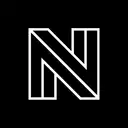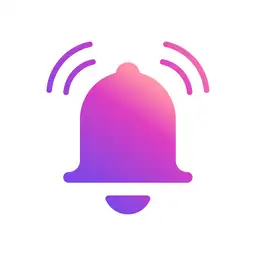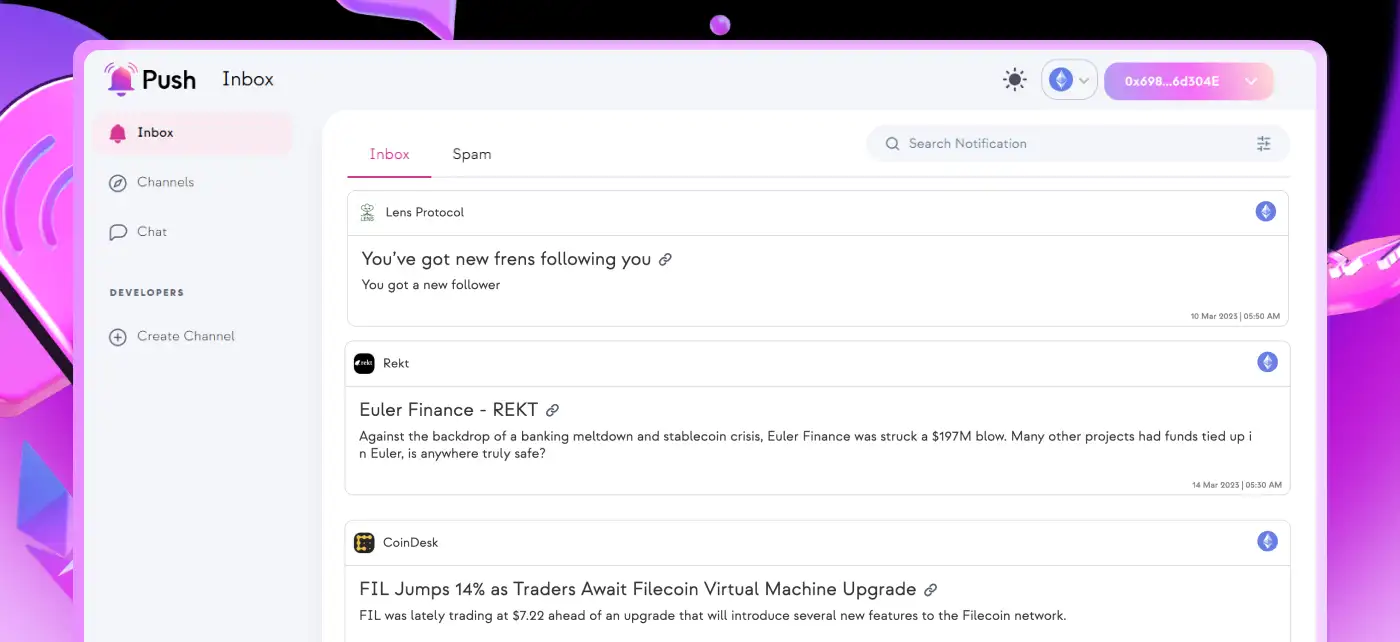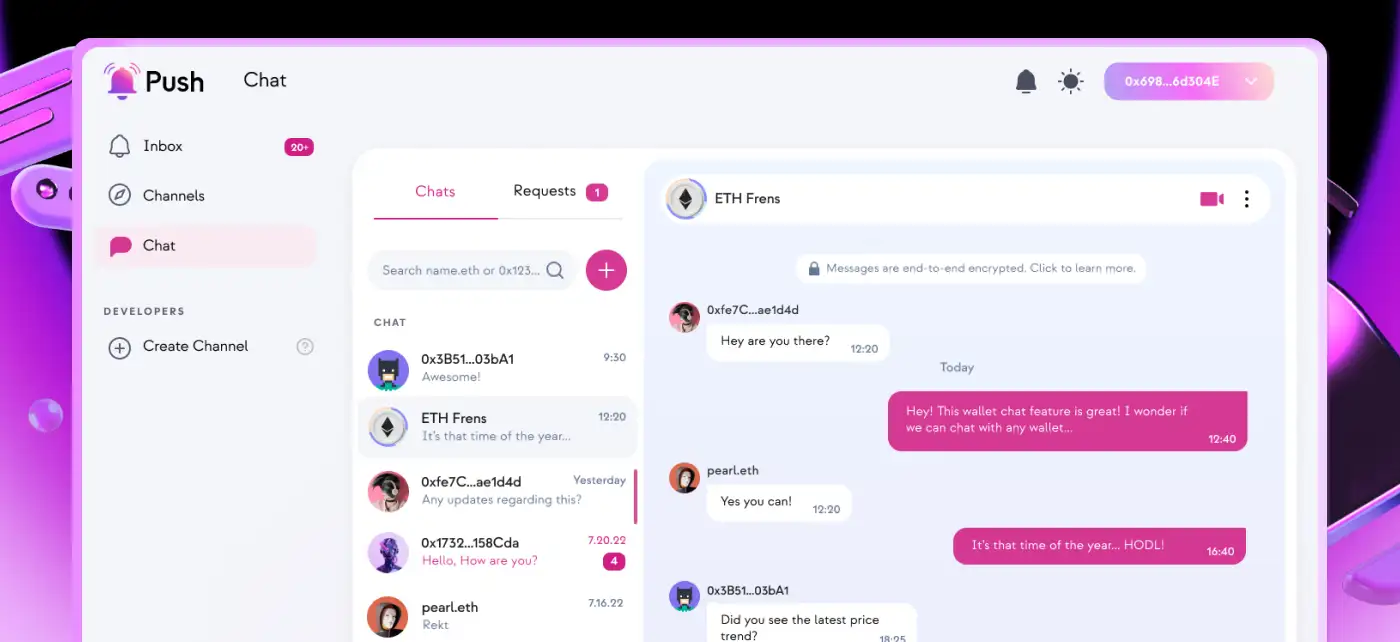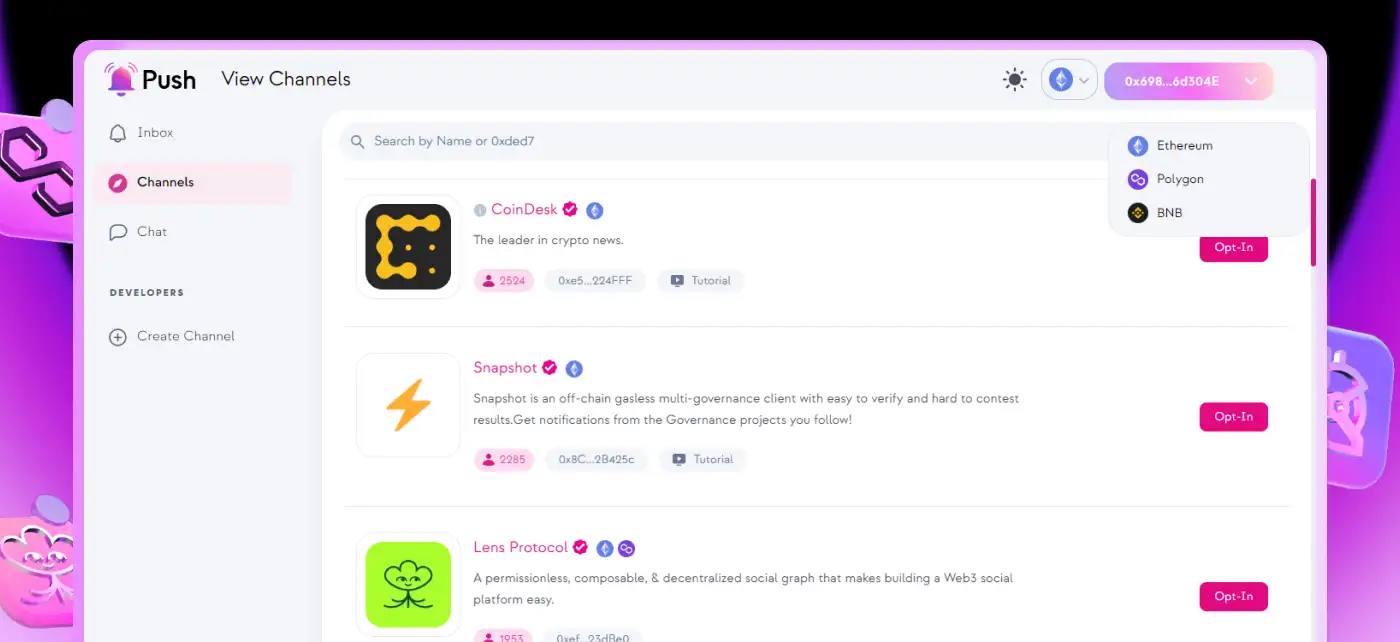About Push Protocol
Push Protocol, previously known as Ethereum Push Notification Service (EPNS), is a pioneering decentralized communication protocol designed to revolutionize how communication occurs within the Web3 ecosystem. The protocol's mission is to provide a robust, scalable communication layer that integrates seamlessly with decentralized applications (dApps) and blockchain platforms. By offering real-time notifications, messaging, and other communication services, Push Protocol aims to enhance the interactivity and user experience of dApps, driving greater adoption and engagement in the decentralized space.
The core philosophy behind Push Protocol is to enable secure, private, and efficient communication directly tied to blockchain identities. Unlike traditional communication platforms that rely on personal identifiers such as email addresses or phone numbers, Push Protocol leverages blockchain addresses, ensuring a higher level of privacy and security. This approach not only aligns with the decentralized ethos of Web3 but also opens up new possibilities for communication that are uniquely suited to the needs of blockchain-based applications.
Push Protocol, initially launched as Ethereum Push Notification Service (EPNS), has undergone significant evolution since its inception. The project was founded to address a critical gap in the Web3 ecosystem – the lack of a native communication layer for decentralized applications (dApps). Traditional communication methods, such as email and SMS, are not well-suited for the decentralized world due to their reliance on centralized infrastructure and personal identifiers. Push Protocol was developed to provide a decentralized, secure, and efficient communication solution tailored to the needs of Web3.
The journey of Push Protocol began with the development of decentralized notifications. This feature allows dApps to send real-time notifications to users based on their blockchain activities. For example, users can receive alerts about transactions, governance proposals, or other significant events directly to their wallets. This capability enhances user engagement and ensures that users stay informed about important updates without relying on traditional communication channels.
Building on the success of decentralized notifications, Push Protocol expanded its services to include Push Chat. Push Chat is a Web3 native messaging protocol that enables secure, encrypted messaging between blockchain addresses. Unlike traditional messaging platforms, Push Chat does not require personal identifiers like phone numbers or email addresses. Instead, it uses blockchain addresses, ensuring a higher level of privacy and security. Users can send direct messages, create groups, and even set conditional access based on token holdings, making it a versatile tool for communication within the decentralized space.
Another significant milestone in the development of Push Protocol is the introduction of Push Video. This service provides decentralized video and audio communication capabilities, allowing users to conduct video calls and conferences directly within the Web3 ecosystem. Push Video integrates seamlessly with other Push Protocol services, providing a comprehensive communication solution that addresses the diverse needs of decentralized applications.
Throughout its development, Push Protocol has focused on interoperability and cross-chain compatibility. The protocol supports multiple blockchain networks, including Ethereum, Binance Smart Chain, and other EVM and non-EVM chains. This cross-chain compatibility ensures that Push Protocol's services can be used across a wide range of dApps and blockchain platforms, promoting broader adoption and utility.
Push Protocol's commitment to decentralized governance is evident in its use of the $PUSH token. Token holders can participate in the governance of the protocol through Push Improvement Proposals (PIPs). This decentralized governance model ensures that the community has a significant say in the direction and development of the protocol. Active participation in governance is incentivized, encouraging token holders to engage in the decision-making process and contribute to the protocol's growth.
As the Web3 ecosystem continues to evolve, Push Protocol remains at the forefront of innovation in decentralized communication. The protocol's comprehensive suite of services, including decentralized notifications, Push Chat, and Push Video, addresses the critical communication needs of dApps and blockchain users. By providing a secure, private, and efficient communication layer, Push Protocol enhances the functionality and user experience of decentralized applications, driving greater adoption and engagement in the Web3 space.
Competitors to Push Protocol in the Web3 communication space include projects like XMTP and WalletConnect, which also aim to provide secure messaging and notification services for decentralized applications. However, Push Protocol's comprehensive approach and focus on interoperability set it apart as a leader in the field of decentralized communication.
- Decentralized Notifications: Push Protocol offers real-time notifications directly linked to blockchain addresses, enhancing the user experience for dApp users. These notifications keep users informed about important events and updates without relying on traditional communication channels.
- Web3 Native Messaging: Push Chat allows for secure, encrypted messaging without the need for traditional personal identifiers. This feature leverages blockchain addresses to ensure privacy and security, enabling truly anonymous communication within the Web3 ecosystem.
- Cross-Chain Compatibility: Push Protocol supports communication across different blockchain networks, including Ethereum, Binance Smart Chain, and other EVM and non-EVM chains. This ensures broad applicability and interoperability.
- Token Gated Experiences: Users can create conditional access to messages and groups based on token holdings, enabling exclusive and secure communication channels. This feature is particularly useful for communities and projects looking to offer premium experiences to their token holders.
- Governance and Incentives: The $PUSH token is used for governance and incentivizing network participants, ensuring a community-driven approach to protocol development. Token holders can propose and vote on protocol changes, actively shaping the future of the Push Protocol.
- Video and Audio Communication: Push Video enables decentralized video and audio calls, allowing users to conduct meetings and conferences directly within the Web3 ecosystem. This feature integrates seamlessly with other Push Protocol services, providing a comprehensive communication solution.
- Privacy and Security: All communications within the Push Protocol are encrypted and stored on decentralized storage solutions like IPFS, ensuring data integrity and user privacy. The protocol also includes mechanisms to prevent spam and ensure the authenticity of messages.
To get started with Push Protocol, follow these steps:
- Create an Account: Visit the Push Protocol app and connect your Web3 wallet. Supported wallets include MetaMask, WalletConnect, and others.
- Subscribe to Notifications: Browse and subscribe to various channels to receive real-time notifications related to your interests and activities. This ensures you stay informed about important updates and events within the Web3 ecosystem.
- Use Push Chat: Navigate to the Push Chat section and start sending messages using your wallet address. You can also create groups and set conditional access based on token holdings, making it a versatile tool for secure communication within the decentralized space.
- Explore Push Video: Check out the Push Video feature for decentralized video and audio calls. This allows you to conduct meetings and conferences directly within the Web3 ecosystem, integrating seamlessly with other Push Protocol services.
- Participate in Governance: If you hold $PUSH tokens, you can participate in the governance of the protocol. Visit the Push Governance portal to propose and vote on improvements and changes through Push Improvement Proposals (PIPs). This decentralized governance model ensures that the community has a significant say in the direction and development of the protocol.
- Learn and Engage: For more detailed guides and tutorials, visit the Push Protocol documentation. Engage with the community on platforms like Discord and follow the latest updates on the Push Protocol blog.
By following these steps, you can effectively integrate and utilize the comprehensive communication services offered by Push Protocol within the Web3 ecosystem.
Push Protocol Reviews by Real Users
Push Protocol FAQ
You can receive notifications on your wallet by subscribing to various channels through the Push Protocol app. Simply connect your Web3 wallet and select the channels that interest you to start receiving real-time notifications.
Push Chat leverages blockchain technology to ensure privacy and security. Unlike traditional messaging apps, Push Chat does not require personal identifiers like phone numbers or email addresses. All messages are encrypted and tied to blockchain addresses, providing a higher level of security and anonymity.
Yes, Push Video allows you to host decentralized video and audio meetings. This feature integrates seamlessly with other Push Protocol services, providing a comprehensive communication solution for the Web3 ecosystem.
Token gated experiences are exclusive communication channels or groups that require users to hold specific tokens to gain access. You can create these experiences using Push Chat, allowing you to set conditional access based on token holdings.
Developers can integrate Push Protocol into their dApps using the available SDKs and APIs. Detailed documentation and quickstart guides are available on the Push Protocol documentation page.
You Might Also Like



